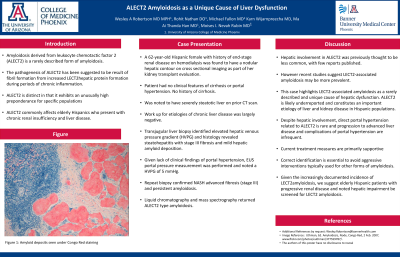Sunday Poster Session
Category: Liver
P1012 - Alect2 Amyloidosis as a Unique Cause of Liver Dysfunction
Sunday, October 22, 2023
3:30 PM - 7:00 PM PT
Location: Exhibit Hall

Has Audio

Wesley A. Robertson, MD, MPH, MPA
University of Arizona College of Medicine
Phoenix, AZ
Presenting Author(s)
Wesley A.. Robertson, MD, MPH, MPA1, Rohit Nathan, DO1, Michael Fallon, MD2, Karn Wijarnpreecha, MD2, Ma Ai Thanda Han, MD1, Moises I. Nevah Rubin, MD1
1University of Arizona College of Medicine, Phoenix, AZ; 2Banner University Medical Center, Phoenix, AZ
Introduction: Amyloidosis derived from leukocyte chemotactic factor 2 (ALECT2) is a rarely described form of amyloidosis. The pathogenesis of ALECT2 has been suggested to be result of fibril formation from increased LECT2 hepatic protein formation during periods of chronic inflammation. ALECT2 is distinct in that it exhibits an unusually high preponderance for specific populations, commonly affecting elderly Hispanics who present with chronic renal insufficiency and liver disease.
Case Description/Methods: A 62-year-old Hispanic female with history of end-stage renal disease on hemodialysis was found to have a nodular hepatic contour on cross sectional imaging as part of her kidney transplant evaluation. Patient had no clinical features of cirrhosis or portal hypertension. She had never been diagnosed with cirrhosis but was noted to have severely steatotic liver on prior CT scan. She was referred to Hepatology for further evaluation. Work up for etiologies of chronic liver disease was largely negative. Transjugular liver biopsy identified elevated hepatic venous pressure gradient (HVPG) and histology revealed steatohepatitis with stage III fibrosis and mild hepatic amyloid deposition. Given lack of clinical findings of portal hypertension, EUS portal pressure measurement was performed and noted a HVPG of 5 mmHg. Repeat biopsy confirmed NASH advanced fibrosis (stage III) and persistent amyloidosis. Liquid chromatography and mass spectrography returned ALECT2 type amyloidosis.
Discussion: Hepatic involvement in ALECT2 was previously thought to be less common, with few reports published. However recent studies suggest LECT2-associated amyloidosis may be more prevalent. This case highlights LECT2-associated amyloidosis as a rarely described and unique cause of hepatic dysfunction. ALECT2 is likely underreported and constitutes an important etiology of liver and kidney disease in Hispanic populations. Despite hepatic involvement, direct portal hypertension related to ALECT2 is rare and progression to advanced liver disease and complications of portal hypertension are infrequent. Current treatment measures are primarily supportive, and correct identification is essential to avoid aggressive interventions typically used for other forms of amyloidosis. Given the increasingly documented incidence of LECT2 amyloidosis, we suggest elderly Hispanic patients with progressive renal disease and noted hepatic impairment be screened for LECT2 amyloidosis.
Disclosures:
Wesley A.. Robertson, MD, MPH, MPA1, Rohit Nathan, DO1, Michael Fallon, MD2, Karn Wijarnpreecha, MD2, Ma Ai Thanda Han, MD1, Moises I. Nevah Rubin, MD1. P1012 - Alect2 Amyloidosis as a Unique Cause of Liver Dysfunction, ACG 2023 Annual Scientific Meeting Abstracts. Vancouver, BC, Canada: American College of Gastroenterology.
1University of Arizona College of Medicine, Phoenix, AZ; 2Banner University Medical Center, Phoenix, AZ
Introduction: Amyloidosis derived from leukocyte chemotactic factor 2 (ALECT2) is a rarely described form of amyloidosis. The pathogenesis of ALECT2 has been suggested to be result of fibril formation from increased LECT2 hepatic protein formation during periods of chronic inflammation. ALECT2 is distinct in that it exhibits an unusually high preponderance for specific populations, commonly affecting elderly Hispanics who present with chronic renal insufficiency and liver disease.
Case Description/Methods: A 62-year-old Hispanic female with history of end-stage renal disease on hemodialysis was found to have a nodular hepatic contour on cross sectional imaging as part of her kidney transplant evaluation. Patient had no clinical features of cirrhosis or portal hypertension. She had never been diagnosed with cirrhosis but was noted to have severely steatotic liver on prior CT scan. She was referred to Hepatology for further evaluation. Work up for etiologies of chronic liver disease was largely negative. Transjugular liver biopsy identified elevated hepatic venous pressure gradient (HVPG) and histology revealed steatohepatitis with stage III fibrosis and mild hepatic amyloid deposition. Given lack of clinical findings of portal hypertension, EUS portal pressure measurement was performed and noted a HVPG of 5 mmHg. Repeat biopsy confirmed NASH advanced fibrosis (stage III) and persistent amyloidosis. Liquid chromatography and mass spectrography returned ALECT2 type amyloidosis.
Discussion: Hepatic involvement in ALECT2 was previously thought to be less common, with few reports published. However recent studies suggest LECT2-associated amyloidosis may be more prevalent. This case highlights LECT2-associated amyloidosis as a rarely described and unique cause of hepatic dysfunction. ALECT2 is likely underreported and constitutes an important etiology of liver and kidney disease in Hispanic populations. Despite hepatic involvement, direct portal hypertension related to ALECT2 is rare and progression to advanced liver disease and complications of portal hypertension are infrequent. Current treatment measures are primarily supportive, and correct identification is essential to avoid aggressive interventions typically used for other forms of amyloidosis. Given the increasingly documented incidence of LECT2 amyloidosis, we suggest elderly Hispanic patients with progressive renal disease and noted hepatic impairment be screened for LECT2 amyloidosis.
Disclosures:
Wesley Robertson indicated no relevant financial relationships.
Rohit Nathan indicated no relevant financial relationships.
Michael Fallon indicated no relevant financial relationships.
Karn Wijarnpreecha indicated no relevant financial relationships.
Ma Ai Thanda Han indicated no relevant financial relationships.
Moises I. Nevah Rubin indicated no relevant financial relationships.
Wesley A.. Robertson, MD, MPH, MPA1, Rohit Nathan, DO1, Michael Fallon, MD2, Karn Wijarnpreecha, MD2, Ma Ai Thanda Han, MD1, Moises I. Nevah Rubin, MD1. P1012 - Alect2 Amyloidosis as a Unique Cause of Liver Dysfunction, ACG 2023 Annual Scientific Meeting Abstracts. Vancouver, BC, Canada: American College of Gastroenterology.
